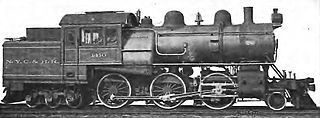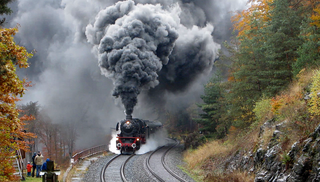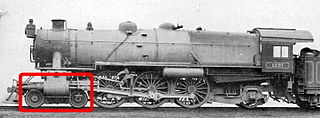
A 4-8-8-4 in the Whyte notation for the classification of steam locomotives by wheel arrangement, is a locomotive with a four-wheel leading truck, two sets of eight driving wheels, and a four-wheel trailing truck. These are commonly known as "Union Pacific Big Boys".
In rail transport, a wheel arrangement or wheel configuration is a system of classifying the way in which wheels are distributed under a locomotive. Several notations exist to describe the wheel assemblies of a locomotive by type, position, and connections, with the adopted notations varying by country. Within a given country, different notations may also be employed for different kinds of locomotives, such as steam, electric, and diesel powered.
The UIC classification of locomotive axle arrangements, sometimes known as German classification or German system, describes the wheel arrangement of locomotives, multiple units and trams. It is set out in the International Union of Railways (UIC) "Leaflet 650 – Standard designation of axle arrangement on locomotives and multiple-unit sets". It is used in much of the world. The United Kingdom uses the Whyte notation. The United States uses the simplified AAR wheel arrangement for modern locomotives.

In the Whyte notation, a 6-2-0 is a railroad steam locomotive that has an unpowered three-axle leading truck followed by a single powered driving axle. This wheel arrangement is associated with the Crampton locomotive type, and in the USA the single class were sometimes referred to as Cramptons.

In Whyte notation, a 2-4-4, or Boston-type, is a steam locomotive with two unpowered leading wheels followed by four powered driving wheels and four unpowered trailing wheels.

Under the Whyte notation for the classification of steam locomotives by wheel arrangement, 6-8-6 represents the arrangement of six unpowered leading wheels arranged into a three-axle leading truck, eight powered driving wheels, and six unpowered trailing wheels arranged into a three-axle trailing truck.

On a steam locomotive, a trailing wheel or trailing axle is generally an unpowered wheel or axle (wheelset) located behind the driving wheels. The axle of the trailing wheels is usually located in a trailing truck. On some large locomotives, a booster engine was mounted on the trailing truck to provide extra tractive effort when starting a heavy train and at low speeds on gradients.
In Whyte notation, 2-4-4-2 refers to a railroad steam locomotive that has two leading wheels followed by four coupled driving wheels, a second set of four coupled driving wheels, and two trailing wheels.
In Whyte notation for the classification of steam locomotives by wheel arrangement, a 2-12-4 is a locomotive with one pair of unpowered leading wheels, followed by six pairs of powered driving wheels, and two pairs of unpowered trailing wheels.

Co-Co is the wheel arrangement for a diesel locomotive with two six-wheeled bogies with all axles powered, with a separate motor per axle. The equivalent UIC classification (Europe) for this arrangement is Co′Co′ or C-C for AAR (USA).
B-B and Bo-Bo are the Association of American Railroads (AAR) and British classifications of wheel arrangement for railway locomotives with four axles in two individual bogies. They are equivalent to the B′B′ and Bo′Bo′ classifications in the UIC system. The arrangement of two, two-axled, bogies is a common wheel arrangement for modern electric and diesel locomotives.
In Whyte notation, a 4-6-6-2 is a steam locomotive with four leading wheels in an unpowered bogie at the front of the locomotive followed by two sets of driving wheels with six wheels each, followed by two unpowered trailing wheels at the rear of the locomotive.

Under the Whyte notation for the classification of steam locomotives, 0-8-4 represents the wheel arrangement of no leading wheels, eight powered and coupled driving wheels on four axles, and four trailing wheels on two axles.

In the Whyte notation for describing steam locomotive wheel arrangement, a 2-6-6 is a locomotive with a two-wheeled leading truck, six driving wheels, and a six-wheeled trailing truck. All the locomotives produced of this arrangement have been tank locomotives, and the vast majority in the United States. It was a popular arrangement for the larger Mason Bogies, as well as some of the largest suburban tank locomotives.
In the Whyte notation for describing steam locomotive wheel arrangement, a 2-8-6 is a locomotive with a two-wheel leading truck, eight driving wheels, and a six-wheel trailing truck. All 2-8-6 locomotives constructed have been 2-8-6T tank locomotives of the Mason Bogie pattern.
Under the French classification system for locomotive wheel arrangements, the system is slightly different for steam and electric/diesel vehicles.

Under the Whyte notation for the classification of steam locomotives, 0-6-6 represents the wheel arrangement of no leading wheels, six powered and coupled driving wheels on three axles and six trailing wheels on three axles.
Under the Whyte notation for the classification of steam locomotive wheel arrangements, a 4-4-6-2 is a locomotive with two pairs of leading wheels, one set of four driving wheels, a second set of six driving wheels, and a pair of trailing wheels.












